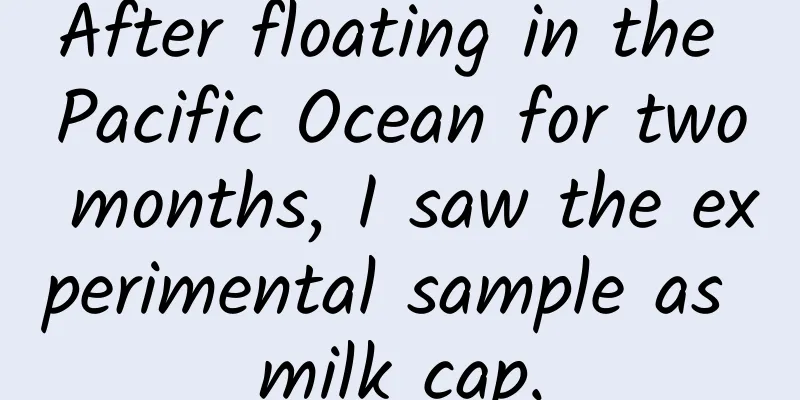After floating in the Pacific Ocean for two months, I saw the experimental sample as milk cap.

|
What do you think of when you mention the Pacific Ocean, the largest ocean? Tropical islands, endless sea horizons, the birthplace of typhoons, or fear of the deep sea, these are just a few of the many faces of the Pacific Ocean. Most of us know very little about this vast neighbor that occupies 1/3 of the Earth's area and can accommodate 19 Chinas. Last summer, I followed the China Ocean Expedition 66 and drifted in the Pacific Ocean for two months, having a brief but intimate contact with the deepest ocean. The scenery I saw during this voyage far exceeded my imagination. A strange sight I saw for the first time in the Pacific Ocean: half of the sky was covered with dark clouds and it was raining heavily, while the other half was the sun slowly setting. Go out to sea on the most advanced research vessel We set sail from Xiamen and headed for the Western Pacific. The main purpose of this scientific expedition is to conduct a survey of cobalt-rich crust resources in the cobalt-rich crust contract area and adjacent waters. Cobalt-rich crust is iron-manganese oxide and hydroxide formed on the surface of seabed rocks. It is rich in cobalt, so it is called cobalt-rich crust. It is an important deep-sea solid mineral resource. my country has exclusive mining rights for many seabed mining areas in the high seas. It is currently the country with the largest number of mining areas and the most complete mineral types in the international seabed area in the world. These precious mineral deposits are of great strategic significance to my country's resource security. The research vessel we boarded was the Deep Sea One, one of the newest ships in my country's research fleet and the first Chinese manned submersible support mother ship - and the manned submersible it was equipped with was the famous Jiaolong. Our research expedition was the first comprehensive ocean survey voyage of the Deep Sea One, in other words, it was the first time it went out to sea without the Jiaolong, and I lost the opportunity to take a photo with the Jiaolong. The "Deep Sea One" has a total length of 90.2 meters, a beam of 16.8 meters, and a displacement of 4,500 tons. It has reached international advanced levels in terms of design concept, technical level, and scientific investigation capabilities. How powerful the "Deep Sea One" is can be seen from the living environment of us ordinary scientific expedition team members - not only are there double rooms and private bathrooms, but there is also a gym and KTV on the ship; each room is also equipped with a TV, which stores a large number of movies, TV series and Jiaolong documentaries, making the two-month life at sea not so long. Swipe left to view the entertainment life on the ship: Picture 1 is the KTV on the ship, and Picture 2 is the TV in each room. There are so many movies stored that even if you watch movies continuously for 24 hours after boarding the ship, you still can't finish watching them after two months off the ship. Is the internet down? Are you seasick? Is the food delicious? The Internet, eating and seasickness are the three issues that I care about most and are most often asked about by my friends. There was no base station signal in the vast ocean, and I was mentally prepared to quit the Internet before setting off. I was also worried that I would not be able to contact my mentor and family. As it turned out, I was totally overthinking. There is no base station signal in the vast ocean, but there are all kinds of strange clouds. I think this cloud looks like a little bear. After the boat leaves the dock, the boat's built-in Wi-Fi will start. Wi-Fi is provided by satellite signals and is much more expensive than traffic on land. Each person is only allowed 600mb of traffic per day, which can be used to contact the outside world through WeChat. Because of limited traffic, the way to obtain information is limited to Moments and public accounts. Other apps cannot be opened due to traffic restrictions. There is no Internet disconnection at sea, but for modern people, it is still a good place to quit Internet addiction. The issue of eating is also very friendly to modern people. We no longer need to worry about the age-old problem of "what to eat today". The chef on board can help us solve it. Usually it is a free buffet with four dishes and one soup. There are fruits at noon, yogurt at night, and instant noodles and biscuits as supper. There is also a "special dinner" of making dumplings and cooking hot pot on Sunday night. At this time, the ship is filled with a festive atmosphere. The food on board is good Seasickness varies from person to person, but generally speaking, the boat was not very bumpy and most people did not feel seasick. Even the students who were most seasick recovered after a week. After getting used to the life of drifting on the boat, we felt a little uncomfortable when we returned to the shore and stepped on the land. It was like walking on cotton for too long and forgetting what it felt like to be on solid ground. For me, the most magical thing is the feeling of sleeping on the boat - like lying on a roller coaster made of cotton, rocking back and forth, or like returning to the cradle, being coaxed to sleep by the rocking embrace of Mother Earth. The sea is quiet at night, without a single noise, no cicadas chirping in the summer, no car horns, only the sound of the waves. The blue of the Pacific Ocean, the unfeeling blue A friend once asked me what my first impression of the Pacific Ocean was. My first reaction was: blue. Pure blue, without any impurities - no matter how I describe it, it can never describe the stunning feeling I had when I first saw it. Sea without filter I think I am not new to the sea. In order to see the blue sea, I once took a six-hour boat ride from Zhoushan to Huaniao Island. When I was in Taiwan, I also went to Kenting and Taitung from time to time. But this is still not the same concept as the blue I saw in the Pacific Ocean. The blue near the coast is a little green, and the sea water is clear and transparent. Under the sunlight, the waves hitting the beach are like transparent gelatinous jelly. It is a gentle, intimate, and life-like color. Although it is extremely clear, it nurtures near-shore organisms and contains more suspended matter than offshore waters. But the blue in the deep Pacific is completely different. It is the most natural color of blue, an inhuman blue, and a lifeless Klein blue. I originally just wanted to take a picture of the equipment in the water, but the sea looked too blue compared to the yellow of the equipment. Of course, the Pacific Ocean is definitely not without life, some birds live on our bow. They usually fly with the ship for several days and nights. These albatrosses are not free bodyguards. During the voyage, fish are often disturbed and jump up, and these flying fish are their best reward. Calendar Girl guessed that this should be some kind of booby Open the blind box of sunset and steal a glimpse of the Milky Way The sunset at sea is always like a blind box. Before reaching the deck, there is no way to guess what color the sunset will be today. There are no high-rise buildings blocking the way here. When watching the sunset, I always want to see the sunset from afar, imagining that my hometown may be at the end of the sea. Whenever I see the gorgeous sunset, I always feel that the epidemic has restricted our pace of seeing the world. I haven't felt the outside world for too long and have forgotten that our planet can be so beautiful. Sometimes the sky is pink Sometimes it's a sunset glow like blood When the sun sets below the sea level, the whole sky becomes dark The photos taken by my friends on my 23rd birthday are memories worth keeping for a long time. When the sun sets from the sea level, the ocean enters another world. The deep sea at night is like an unknown uninhabited land in the Cthulhu mythology, full of secrets and hidden dangers. The captain was worried about our safety and did not allow us to go to the deck after nightfall, but we still occasionally sneaked to the deck to look up at the stars. The cabin walkway leading to the deck was lit with bright yellow lights, like a warm world; but when I opened the cabin door, it was completely dark outside, like a deep well, without a single ray of light. Looking back, the moment I opened the cabin door, I was actually full of fear. But when I closed the cabin door and walked into the darkness, the world seemed to have lost its vision, and I began to feel the tranquility of the night and the unknown of the sea. Hatch leading to the deck Looking up at the sky, there are only the moon and the morning star, and the Milky Way is gradually getting brighter. Those stars come from the distant outer space. When they set out from the stars and embarked on the long journey of the universe, the earth was still a desolate place. But after a long interstellar journey, it arrived on the earth and was seen by you at sea. Everything is so coincidental. I still remember clearly that when a meteor fell from the sky that day, my eyes were wet without warning, as if an electric current had passed through me, and I stood there in a daze. Perhaps it is the pursuit of romance and the exploration of the unknown that inspires us to explore farther into space and dive deeper into the sea. Starry sky captured from the boat What is a scientific expedition workday like? It takes about a week from departure to arrival at the Western Pacific work area to start operations. This period is called the "cruise phase", during which we, the new team members who are on board for the first time, will receive safety training, first aid training and abandon ship drills. Abandon ship drills are a compulsory course for every voyage, and we must be familiar with important information such as the abandon ship signal, the assembly point after the abandon ship signal is issued, and the location of the lifeboat. Although I wrote a lot of beautiful scenery, scientific research is the real mission After arriving at the work area, the real work began. Surveying mineral resources is a systematic work that requires the participation of personnel from different professions. According to the different fields of the scientific expedition team members, they are divided into six professional groups: hydrology group, biology group, microbial gene resources group, chemistry group, geology group and geophysics group. As a member of the chemistry team, I participated in the environmental baseline survey. The environmental baseline refers to the basic chemical composition of each environmental element in an area when it is unaffected. The mining process will inevitably have an impact on the deep-sea environment. Therefore, collecting environmental baseline data and species diversity in relevant sea areas in advance can not only help us better understand this deep sea, but also conduct preliminary research on the environmental pollution that may be caused by deep-sea mining. After all, environmental protection and mining are inseparable like the two sides of a coin. However, after drifting on the sea for two months, when I looked at my experimental samples - sediments collected from the deep seabed, I always thought of shrimp balls and milk caps... After two months on the ship, I missed the milk tea shop very much The project I participated in was not carried out until the end of the voyage. Before the project started, my main role on the ship was to be a laborer and assist other groups. The most common assistance work was to pull ropes - unlike on land, there are often bumps and waves on the ship, and the equipment will shake left and right. These equipment are often measured in tons, and once they shake, they will bring danger to the people and equipment on the ship. Therefore, in addition to using the crane as the main force, manpower is also needed to pull ropes from both sides to better fix the lifting and retraction of the equipment. I can't remember how many pairs of gloves I wore out in two months. Working photos of retracting and releasing anchor The work of the biology group is one of the most interesting tasks in my opinion. They have to investigate the biological resources in a certain sea area, and usually sink the device with food into the deep sea to attract nearby fish to come and eat. About a day later, the equipment in the deep sea will be brought up. Because the rising speed is too fast, the fish in the equipment will sacrifice themselves for science due to the pressure change and stay in the equipment forever. What I didn’t expect was that the food used in the equipment to lure deep-sea fish turned out to be chicken wings from the kitchen. I saw the cottontail "caught" from the 5,000-meter deep sea. Their bodies are transparent in the sun. Although it’s not right, my first reaction is that they might be good as sashimi. The fish caught by the biology team from the seabed During the experiment phase, there was no romantic moment of watching the sunset and the stars, and working all night was commonplace. But after the all-night experiment, when I went to the deck to feel the sea breeze and see the pink sunrise, all the fatigue seemed to go with the wind, leaving only the feeling of an inexplicable sense of accomplishment at the end of the experiment. The story of those 60 days on the Deepsea One is like Peter Pan's days on Neverland, a time of utopia. Perhaps many years later, I will not remember clearly, but I will always remember the cartoon-like sky I saw when I stepped out of the cabin after an all-night experiment; I will remember standing on the deck every day, watching the romantic sunset after the sun fell into the tropical Pacific Ocean; I will remember lying on the deck with a group of good friends, looking up at the starry sky, watching the sky gradually darken, and playing "Under the Sea" in my ears, from dusk to dark night, from the twinkling stars in the sky to the Milky Way filling the sky. Watching the stars twinkle from the sunset on the deck with good friends, that day was like a cartoon The ocean, this mysterious and magnificent blue land, has infinite charm, attracting us to continue exploring. Author: Plato Editor: Mai Mai This article comes from the Species Calendar, welcome to forward If you need to reprint, please contact [email protected] |
>>: The origin of the dreaded HIV virus turns out to be like this!
Recommend
Tofu contains high levels of estrogen. Will men who eat too much become effeminate and women who eat too much get cancer? The truth is out.
Tofu contains high levels of estrogen. Will men w...
How can corporate network promotion acquire customers through Baidu Tieba?
Different online promotion methods generally have...
5 steps to quickly increase the popularity of your live broadcast room!
Live streaming has become a widely known sales me...
Driving sharing model: the secret to getting users to actively share traffic
Since the Internet traffic dividend began to grad...
High-pressure water cannot reach the top, so people cannot live above the 30th floor? How to put out fire and escape from high-rise buildings?
Fire, this word sounds far away from us, but it i...
QQ is really tough! Updated 4 new features to target primary school students
Today, QQ on PC and QQ on mobile suddenly had an ...
vivo Global Mall: Universal pickup code design for e-commerce platforms
Author|vivo official website mall development tea...
How to deploy DOU+ most effectively? Chen Jiangxiong: Douyin DOU+ high-end paid courses Baidu Netdisk (worth 9980)
If you chat with a stranger and say, "Brothe...
Looking up at the night sky, the stars are bright and dim. How long does it take for the starlight to travel to our retinas?
How long it takes for starlight to reach our reti...
[2016 latest edition] A complete list of professional terms in the mobile Internet industry!
Mobile Internet Professional Level 4 Exam is here...
Supernova warning! Astronomers have discovered a way to predict when stars will "self-destruct"
Supernova warning! Astronomers have discovered a ...
How to build a community from scratch?
The benefits of Internet traffic are gradually di...
How much does it cost to customize the Xiangyang fabric mini program?
There are two types of customization for Xiangyan...
Detailed explanation of the promotion and operation strategies of the loan industry!
First, let’s analyze Daichao’s business processes...
Ningbo Mini Program Production Company, how much does it cost to produce a home textile mini program?
How much is the quotation for home textile produc...









